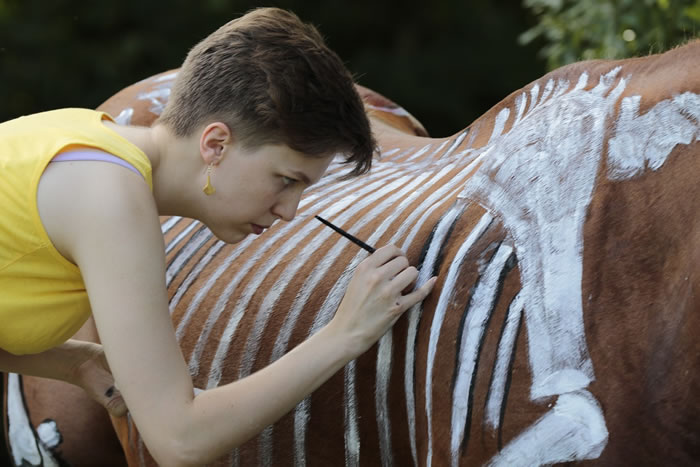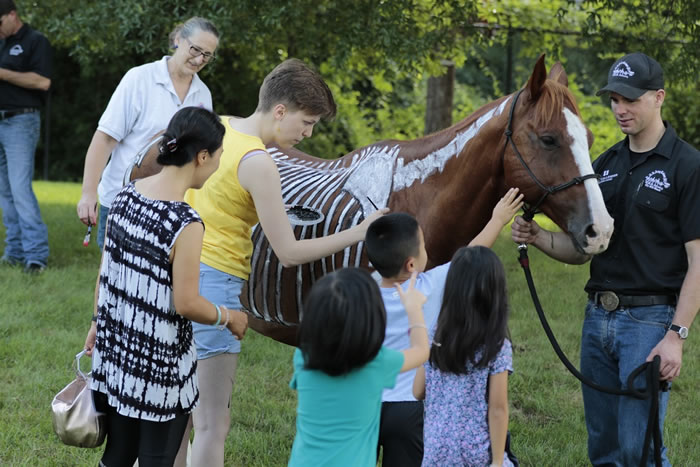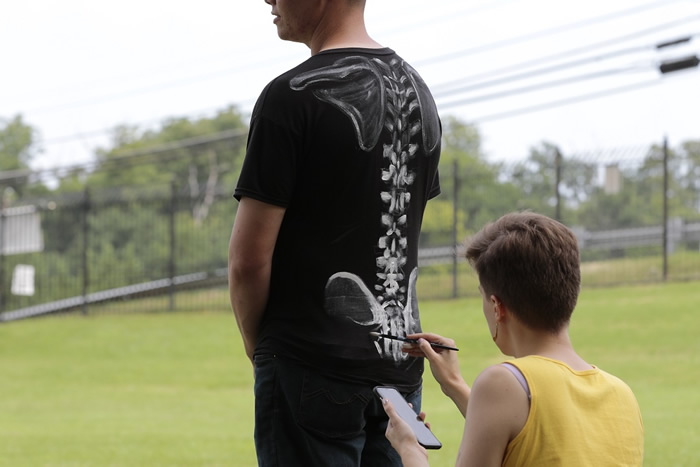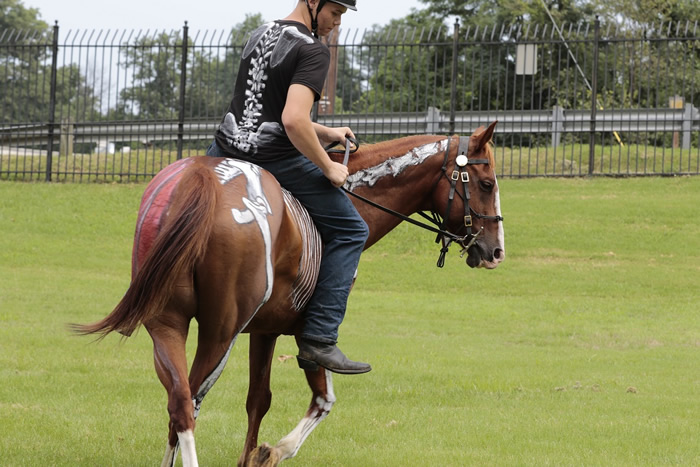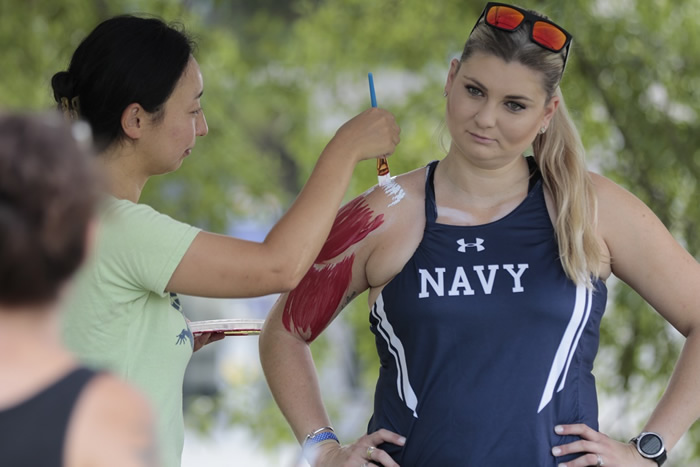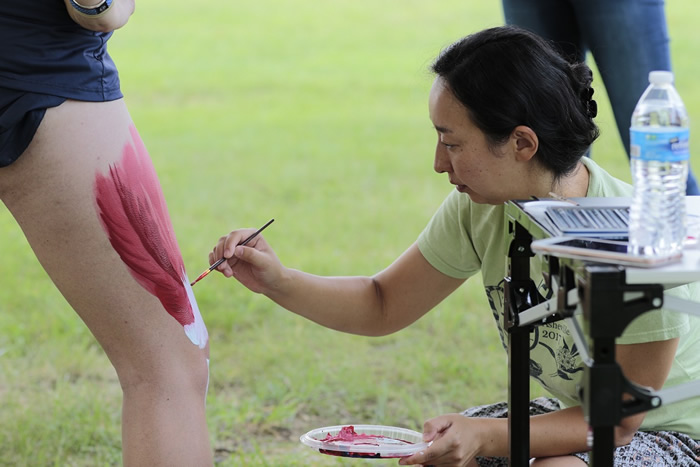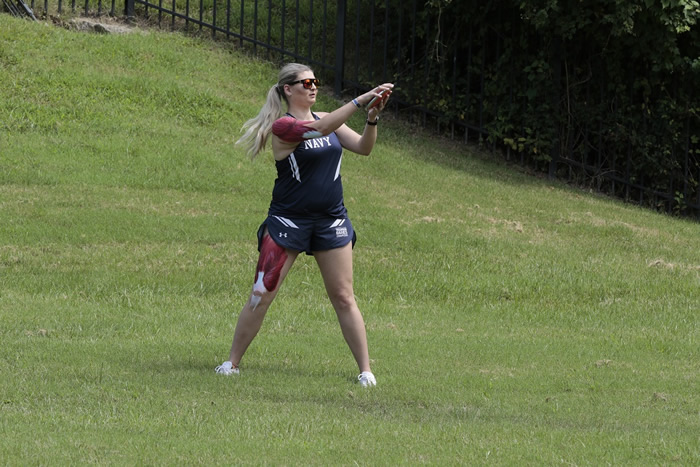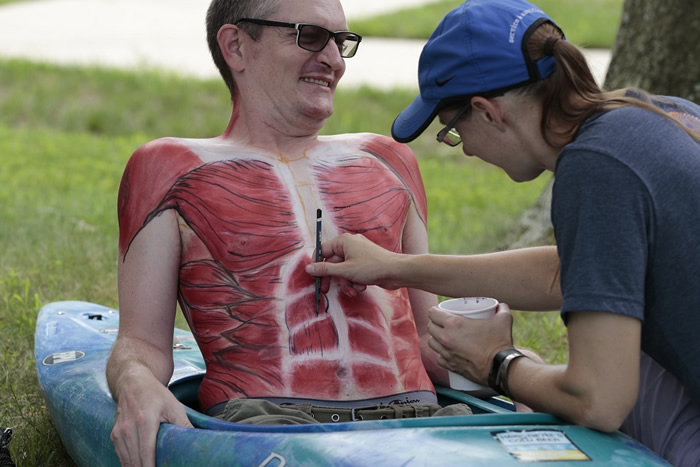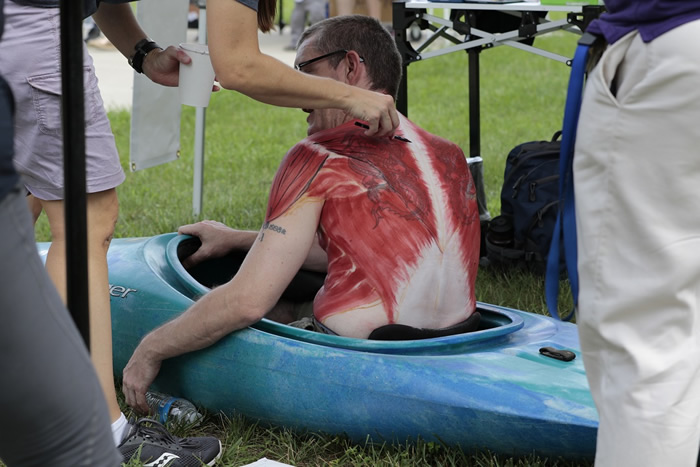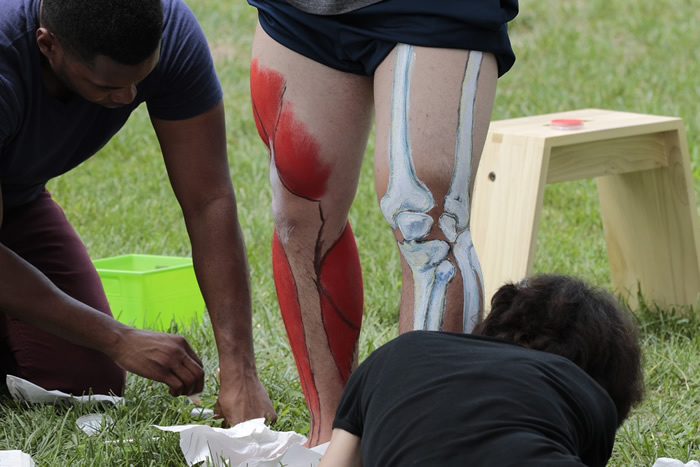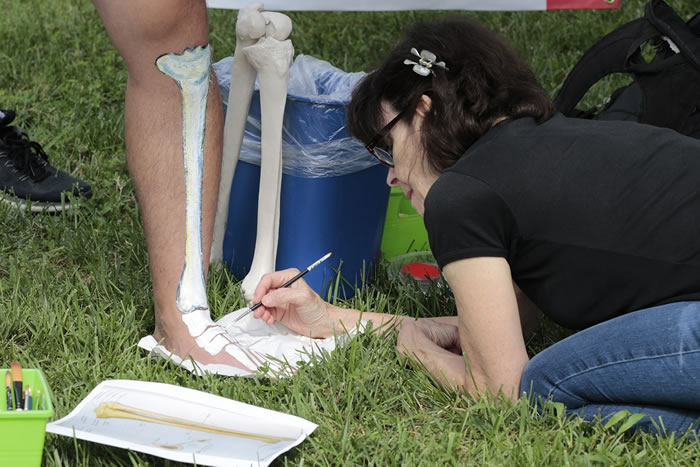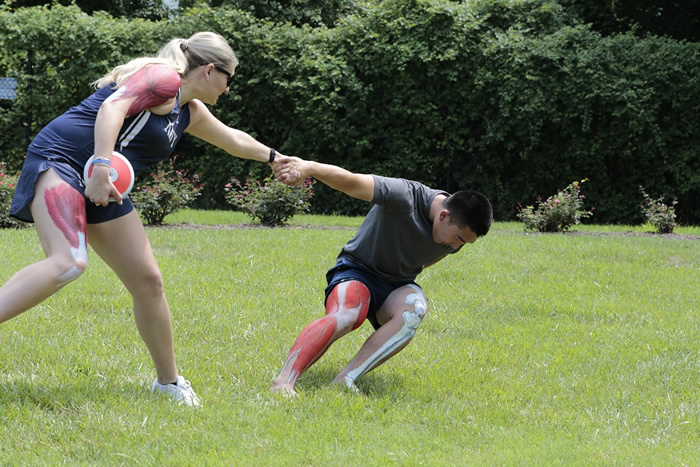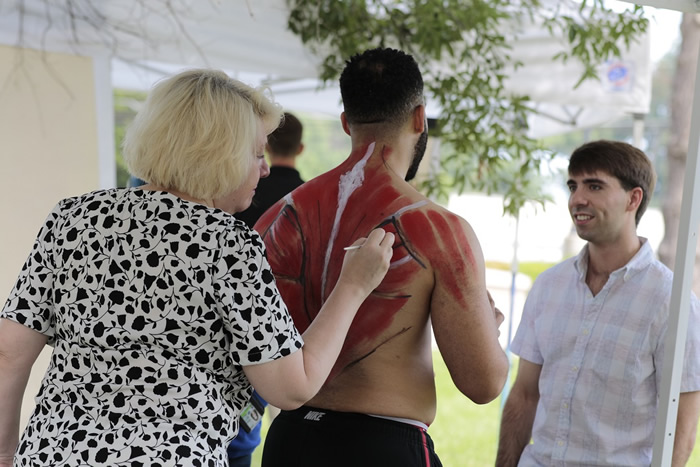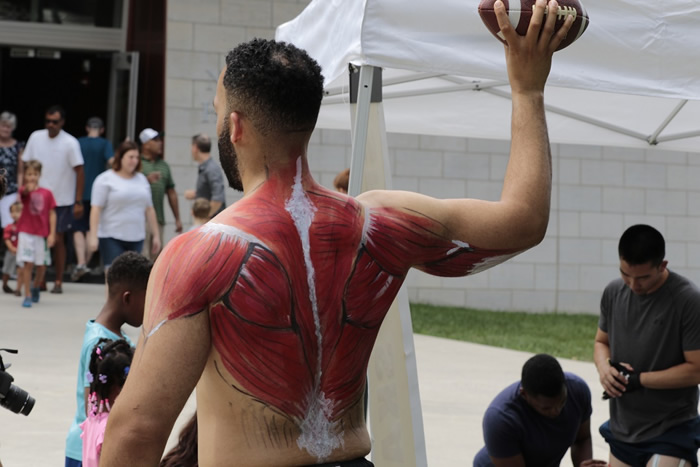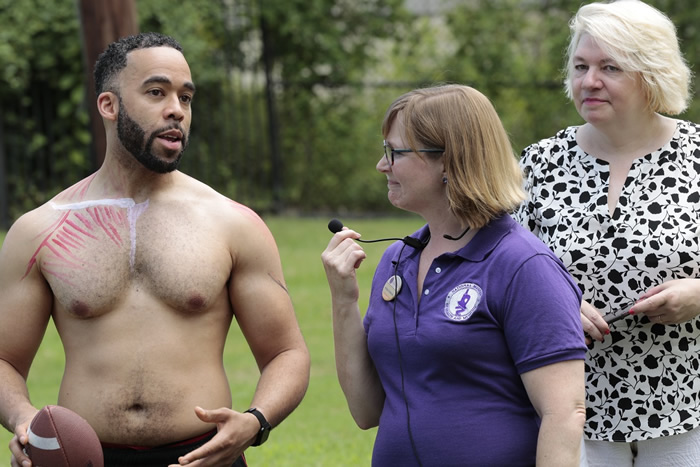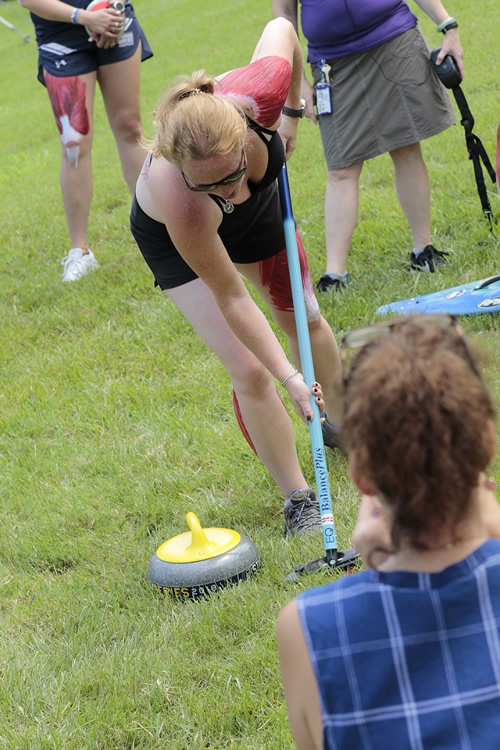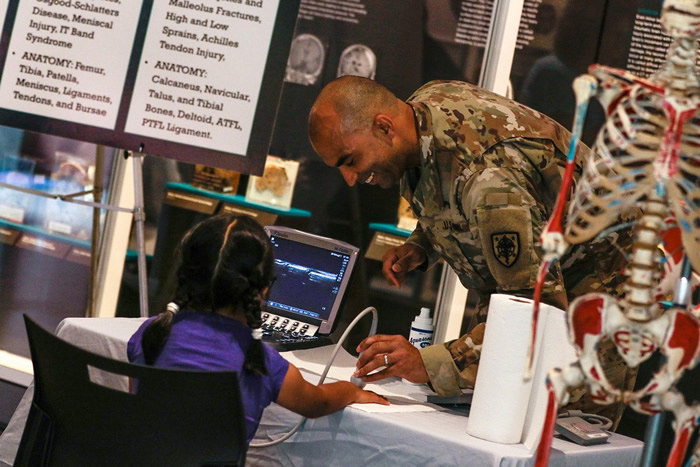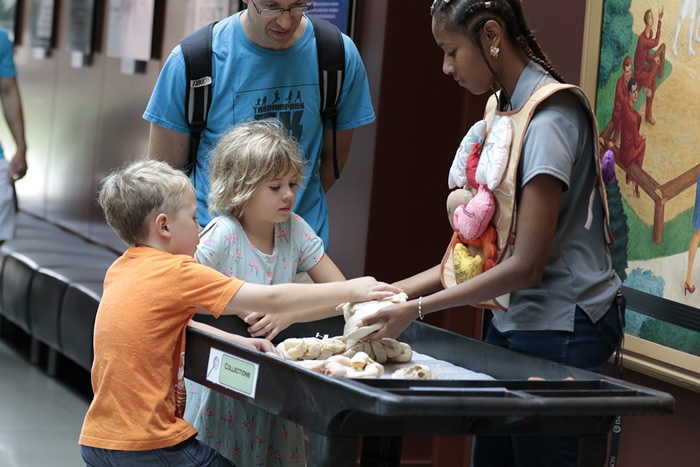Athletes and Anatomy Featured at Military Medical Museum Medical Illustration Program
By Lauren Bigge
NMHM Public Affairs Coordinator
Showcasing anatomy by highlighting athletes and a horse with body paint mesmerized visitors of all ages at the National Museum of Health and Medicine (NMHM) on Aug. 11. The museum's "Anatomy of Sports" program – now in its seventh year – pairs medical illustrators with athletes and physical therapists to emphasize how the muscles, tendons, nerves, and bones work together in the context of sports such as speed skating and football.
Elizabeth Weissbrod, who has been painting during this annual event since 2012 and is a member of the Association of Medical Illustrators, got to work applying red and white strokes to Team River Runner kayaker Brian Isenhour's torso, shoulders and back. "As you're lifting your arms, the traps (trapezius), the rotator cuffs, and the deltoids are involved," University of Maryland (UMD) physical therapy student Allison Berger explained to visitors. "Whatever group of muscles is twisting against the water is going to have that increased resistance, and get built up."
Berger was part of a group of physical therapy students from UMD who volunteered to speak with the event attendees about areas of the anatomy that are active during different sports.
Marie Dauenheimer, a certified medical illustrator, painted Dr. Calvin Baxter's back, chest and arms to show off the muscles he uses while playing football. She noted that she could see his muscles and the bony landmarks very easily. "I'm starting with pastel, to build up some of the muscle fibers," Dauenheimer said. "You start to see muscles interacting. I'm trying to get a little bit of a shadow with the deltoid."
Baxter chatted about his work and activities as a physical therapist with visitor Joseph Sardegna, an occupational therapy student from Falls Church, Va. Sardegna had plenty of questions for Baxter, who enthusiastically responded. "Anatomy was my favorite class," Sardegna explained.
This year's "Anatomy of Sports" was Navy Petty Officer 2nd Class Cassidy Busch's first experience in having Ikumi Kayama, a member of the Guild of Natural Science Illustrators, paint her right arm and thigh. "She's an excellent model," Kayama said, noting Busch's muscle definition. Busch represented field games for the program, and just competed in the 2018 Department of Defense Warrior Games in June. "I'm talking about the muscle groups you use, and how much of the body you use to throw something," she said. A UMD physical therapy student, Jon Hermansen, explained to visitors that her deltoid muscles need to be strong for lifting.
Equestrian participant Skeeter came from the equine-assisted therapy program for wounded warriors and active-duty patients at Fort Belvoir Community Hospital. Another horse named Klinger from Fort Myer was also on hand for "Anatomy of Sports," representing the Caisson Platoon of the 3d U.S. Infantry Regiment (The Old Guard). Skeeter stood still as medical illustrator Elizabeth Lockett, the museum's Human Developmental Anatomy Center collections manager, worked with Rachel Cornell to paint his legs, neck, and body with red, white and black brush strokes. "This is a different medium for me," said Cornell, a medical illustrator.
Certified medical illustrator Joan Tycko painted curler Courtney Shaw's legs and left shoulder. Shaw demonstrated lunges, showed how the arms and shoulders are involved in sweeping, answered questions about starting out in a sport that is not well-known, and confirmed she has played in the national championship twice. "They introduced the two-person curling this year at the Olympics, because it's a little shorter and moves a little faster," Shaw said. "I use a lot of this leg for stabilization as I'm sliding and balancing to travel with that stone," she added, indicating her left thigh covered with red paint.
Illustrator Alice Tangerini and Vondel Mahon, currently a student in the Department of Art as Applied to Medicine at the Johns Hopkins University School of Medicine, painted speed skater Joseph Lee's legs. Lee told visitors that the muscles become strong as a result of single leg training. "We're doing different views of the bone," Tangerini pointed out.
As the painting concluded, all the illustrators and athletes gathered together in front of the crowd of visitors. Andrea Schierkolk, NMHM public programs manager, explained that the 2012 Summer Olympics inspired the launch of this program. "We think this is a great way for NMHM to highlight anatomy and human performance and to promote readiness," she said.
Jason Shipley, UMD adjunct faculty member, told everyone the program was a great opportunity for the UMD physical therapy students. "These muscles, ligaments, tendons, and bones are working for us so that we can do the things we enjoy," he said. "That comes into play for us as physical therapists, in trying to help our patients."
At the Uniformed Services University of Health Sciences anatomy demonstration table inside the museum, Edward Jones, instructor of anatomy, neuroscience and histology, showed visitors a skeleton model and spoke about how bones, muscles, tendons, and ligaments connect and function. "We're talking a lot about ACL (anterior cruciate ligament) tears; some of their favorite athletes have ACL tears," Jones said. His colleague, Army 2nd Lt. Micheal Irelan, used an ultrasound to show children how their hand muscles work as he explained that the machine is used like a portable X-ray.
Heidi Lenzini, representing the A Head for the Future initiative, was also on hand to provide information about traumatic brain injury prevention and recovery, and showed visitors how to properly wear a bicycle helmet. A Head for the Future, launched by the Defense and Veterans Brain Injury Center, provides resources to help the military community prevent, recognize, and recover from traumatic brain injury.
Since its founding in 1862, the NMHM has employed medical illustrators. The museum's collection of medical art includes illustrations from the nineteenth century through to the 1960s. A wide range of military medicine subjects are covered in the museum's medical illustration collections: battlefield injuries, anatomical and pathological studies, hygiene and preventive medicine measures, and surgical techniques. Programs like "Anatomy of Sports" provide an opportunity to continue the tradition of using art as a means by which to educate the public about anatomy.
"Anatomy of Sports" was developed to highlight the importance of science, technology, engineering, art and math (STEAM) related concepts to the public from around the D.C. metropolitan region. Programs like "Anatomy of Sports" connect the mission of the Department of Defense museum with the public. NMHM is a division of the Research and Development Directorate of the Defense Health Agency. For more information on upcoming events, call 301-319-3303 or visit www.medicalmuseum.mil.
